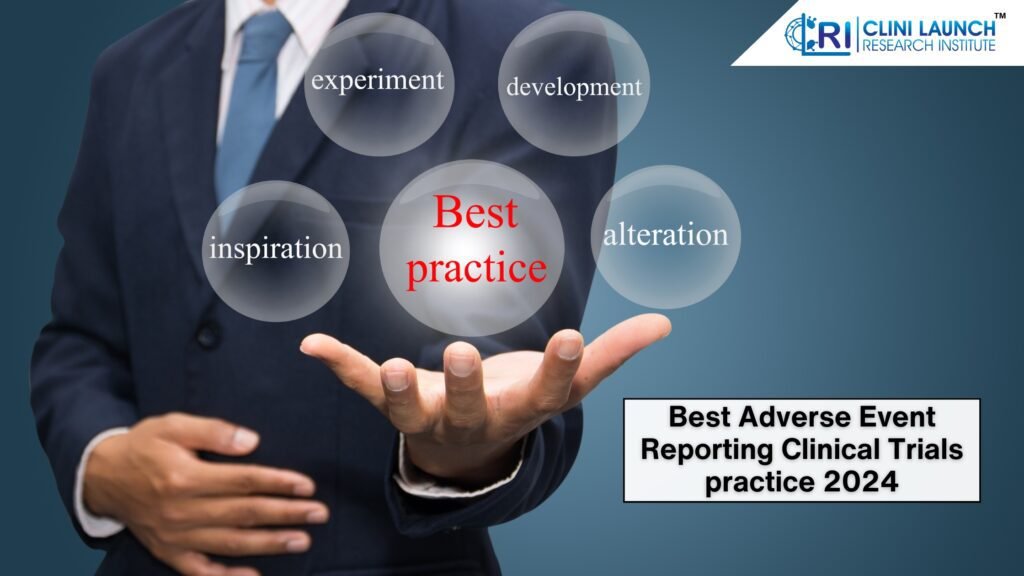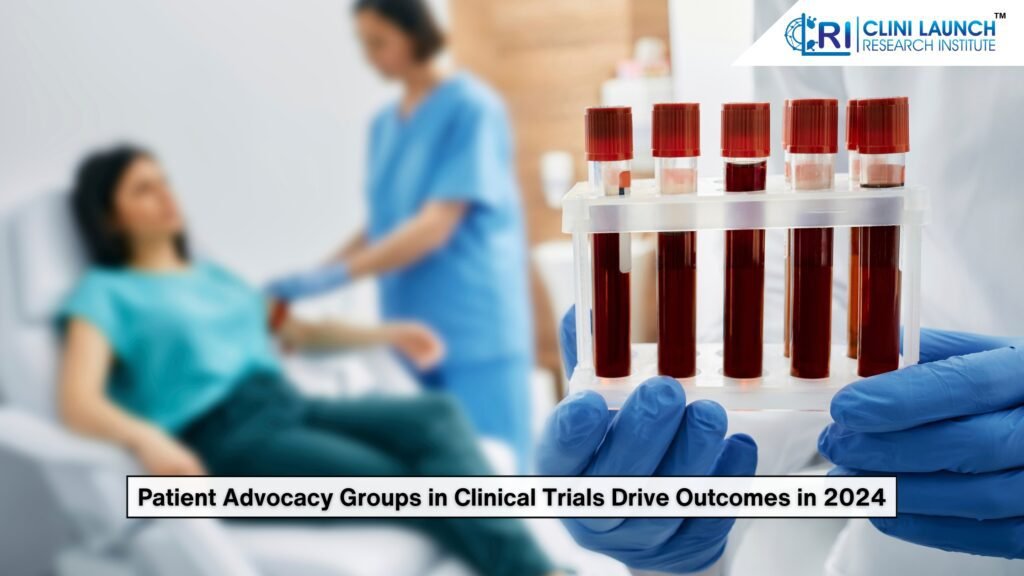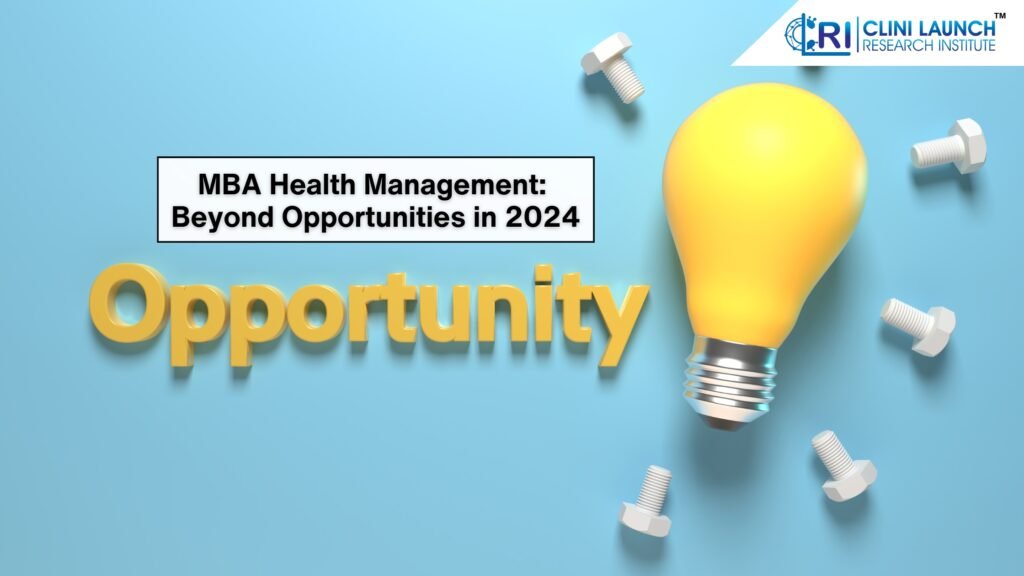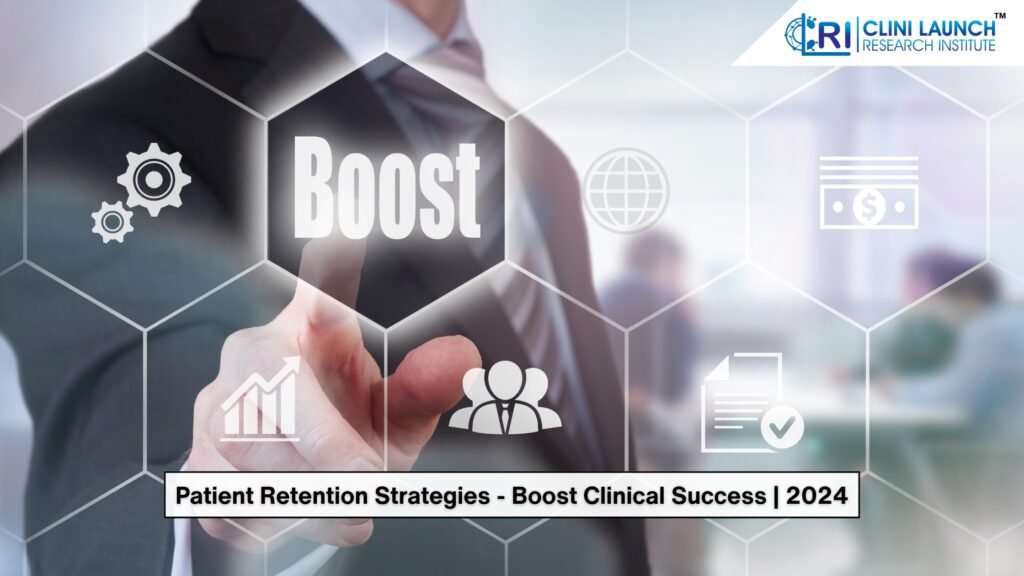Top 5 Clinical Research Trends in Healthcare | 2025

Explore the top 5 clinical research trends transforming healthcare. Learn how CLRI’s Clinical Research Courses can help you excel in this dynamic field. Join us today!
Is an MBA in Hospital Management A Lucrative Career Path?

If you are a passionate healthcare professional and ready for your next step, dream big, make a change in innovation, and make an impact on patients lives! A Masters in Business Administration (MBA) in Healthcare Management can be a powerful tool to transform your career and enhance your leadership quality in the healthcare domain. An MBA in hospital management bridges the gap between business expertise and medical knowledge, playing a crucial role in patient care. As health administration masters responsibilities grow, effective leadership ensures the availability of providers, resources, and funding to meet patient needs. This program equips MBA healthcare professionals to tackle these challenges, fostering strong leadership skills to drive healthcare advancements. To unlock your leadership potential and enhance your future career in healthcare, enrolling for an MBA in hospital and healthcare management empowers you to achieve your goals. To know more, enrol for MBA in healthcare management What is MBA in Hospital Management? An MBA in Hospital and healthcare management is a specific tailored business degree course mainly focusing on administration and leadership domain of healthcare industry. It provides extensive knowledge to students to blend business principles with healthcare operations, covering numerous topics such as healthcare policies, financial management, strategic planning, human resources, and marketing. Earning a degree in MBA hospital administration will help you understand the details regarding different aspects to manage healthcare and hospital settings. This specially tailored program prepares students to effectively manage hospital resources, optimise patient health, and navigate complexities of the healthcare domain. Freshers and graduates are armed to take on leadership roles in clinics, institutes, hospitals, pharmaceutical industries, and healthcare industries, improving patient outcomes, and driving the overall success of healthcare institutions. Scope and Recognition of MBA in Hospital Management Credit: Karthik C (Graphic Designer at CliniLaunch) An MBA in Healthcare Management can help job searchers in the healthcare domain by offering a combination of business expertise and healthcare knowledge. Over the years, there have been a lot of expectations and demands in this healthcare administrative sector. Recently at Indeed job portail 4000+ jobs were posted for the healthcare manager role in the healthcare sector. By completing MBA in healthcare program one can get into various different leading professional and management roles, including: Benefits of MBA in Healthcare Management Credit: Karthik C (Graphic Designer at CliniLaunch) An MBA health administration masters program offers numerous benefits to professionals and healthcare providers along with freshers to make a lasting impact on the healthcare industry. To explore how this degree can transform your professional journey take a closer look at the benefits: Flexible Schedule In MBA in healthcare management one of the key benefits is the study timing schedules. You can have your online courses at your preferred timing. You can select timing and schedules for MBA courses as per your convenience. As there is no fixed timings and schedules you can get enrol to courses that prefer your prior commitment such as work, family and others. Read our blog post : MBA Health Management Work-Life Balance The structure of an MBA in hospital management program is designed to fit around your ongoing professional work. Which will allow you to continue in your current job role while pursuing the management program.You can apply your hands-on real time experience to your on-going job, reinforcing your skills and tackling workplace challenges. Thus you can manage your work life balance as per your tailored course which in long run helps you grow professionally by reinforcing your learning without taking a career break, enhancing your effectiveness and boosting career advancement. Diverse Career Opportunities Post completion of an MBA in hospital and healthcare management opens doors to numerous career opportunities which were out of reach previously. The MBA in healthcare management program provides you with extencive business and management skills applicable to various opportunities in the healthcare sector. Freshers, graduates and proffesionals can pursue roles such as Health Services Manager, Project coordinator, Healthcare Marketing Manager, Pharmaceutical Project Manager, and much more. These profesional roles broaden the expertise in this field, including strategic planning, hospital management, and marketing strategies, positioning individuals for enhancing and advancement of new opportunities in the healthcare domain. To know more, enrol for MBA in healthcare management Job Opportunity and Salary Post completing an MBA health administration masters, one can have a list of different professional roles with competitive salary expectations. These MBA in healthcare roles span across different sectors providing various opportunities and expand your skills in the healthcare horizon. The salary offering for various professional roles depend upon your experience, project collaboration, course credibility and internship you have done. Few job roles such as health information manager, hospital CEO can bag high income such as INR 8L to 40L annually. Some senior roles such as financial analyst, operational manager, clinical manager, hospital financial manager can bag an income ranging from 4 Lakhs to 10 Lakhs annually. These health administration masters cover a variety of industries, giving candidates lots of chances to put their abilities to use and succeed in the fast-paced world of healthcare administration. Your experience, collaborative projects, work functions, program reputation, and other factors will affect the final pay call. One of the most significant takeaways from this blog is that it is always preferable to learn from a reputed institute, work on a project, do an internship, work part time for experience depending on your timetable. This additional experience can help your CV stand out to the world’s leading multinational corporations and recruiters. Dual Specialization Programs from CliniLaunch Credit: Karthik C (Graphic Designer at CliniLaunch) MBA in hospital management programs will provide you advancement in your career by advancing your knowledge. You can enrol for an executive MBA in hospital administration and healthcare management, you will be getting the advantage to pursue one more specialisation. CliniLaunch offers specialisations and the courses are IAO, LSSSDC, NSDC, and IAF accredited. These courses are affiliated with Grade A++ NAAC accredited Bangalore University. Healthcare Management (Major) In this course we are offering a major course
MBA Healthcare Management: An Astounding Degree to Pursue in 2024

Gain critical insights and leadership skills to excel in the fast-paced healthcare management. Enroll for MBA healthcare management in 2024.
Best Adverse Event Reporting Clinical Trials Practice 2024

Clinical trials are the cornerstone of medical progress, meticulously evaluating new drugs and treatments for safety and efficacy. Throughout this process, patient safety is of the utmost importance, and adverse event reporting clinical trials is essential to guaranteeing both the success of a clinical study and the well-being of the patients. Any negative and unexpected sign, symptom, or abnormality in the laboratory linked to the administration of an experimental medication or medical technology is called an adverse event. Researchers can detect possible dangers connected with the intervention and make well-informed decisions about whether to continue the trial using effective adverse event reporting. Not only is this data essential for patient safety, but it also makes a major contribution to the significance of adverse event reporting in medical research. Robust adverse event reporting (AE) enables researchers to revise guidelines for adverse event management and develop best practices for adverse event reporting by giving a complete picture of the impacts of the intervention. Adverse Event Reporting Clinical Trials – The Complexities Credit: Karthik C (Graphic Designer at CliniLaunch) Adverse event reporting in clinical trials can be a challenging procedure, despite its important function. Identifying and categorizing AEs is one of the main issues. The picture may be complicated by pre-existing disorders, symptoms may be mild, and it may be challenging to distinguish between an AE and a typical physiological response. The establishment of best practices for adverse event reporting may be hampered by this ambiguity, which may result in underreporting. Another level of complication is added by negotiating the labyrinth of regulatory requirements and compliance. Adverse event reporting in clinical trials is governed by regulations set forth by regulatory agencies such as the FDA. Adhering to these regulations necessitates close attention to detail. There are obstacles in data analysis and management as well. A large quantity of data is generated by adverse event reporting, and it is essential to gather, store, and analyze this data effectively. To guarantee data quality and integrity, effective adverse event reporting requires strong data management systems and qualified staff. Lastly, it is impossible to exaggerate the effect that underreporting has on trial results. Incomplete data sets make possible hazards harder to see and make it more difficult for researchers to evaluate the intervention’s safety profile. Delays in approvals may result from this, endangering patient safety and eventually impeding the clinical trial’s overall success. Importance of AE Reporting in Medical Research -The CliniLaunch Advantage Credit: Karthik C (Graphic Designer at CliniLaunch) Patient safety must always come first throughout research trials. To accomplish this, adverse event reporting clinical trials reporting is essential. Leading research organization CliniLaunch, renowned for its best practices in clinical research, provides researchers with the skills and resources they need to handle AE reporting efficiently. In order to minimize hazards and guarantee prompt intervention, early detection and reporting are essential. CliniLaunch stresses how crucial it is for research personnel to receive thorough training in order to identify the possible importance of AE reporting in medical research. This entails training staff members on standardized language (such as MedDRA) and cultivating an environment of candid communication where participants feel at ease disclosing any negative experiences. For proper analysis of AEs, standardized data collection and management are necessary. Electronic data capture (EDC) devices are among the effective data collection techniques that Clinilaunch provides researchers with. By reducing errors and guaranteeing consistency, these solutions enable effective AE management. The AE reporting process is further streamlined by utilizing technology. CliniLaunch emphasizes the advantages of using specialist software for reporting and tracking aftereffects. This kind of software expedites communication with regulatory bodies, simplifies data processing, and automatically generates follow-up report reminders. The Ripple Effect – Benefits of the Importance of AE Reporting in Medical Research One cannot stress the importance of AE reporting in medical research. A well-implemented AE reporting plan has several advantages: By prioritizing adverse event reporting and implementing robust strategies, researchers are able to significantly enhance the overall quality and impact of their clinical trials. A Roadmap to Success – Implementing Effective Adverse Event (AE) Reporting Credit: Karthik C (Graphic Designer at CliniLaunch) Building a robust adverse event (AE) reporting system is crucial for safeguarding patient safety and ensuring the success of clinical trials. Here are some key steps: 1. Develop Standard Operating Procedures (SOPs): Clearly define SOPs outlining best practices for adverse event reporting that are essential and cannot be omitted. These SOPs should encompass standardized AE definitions, data collection methods, and reporting timelines. 2. Invest in Training and Education: Comprehensive training for investigators and research staff is vital. This training should cover guidelines for adverse event management, AE identification and classification, and the importance of AE reporting in medical research. 3. Leverage Technology: Utilize electronic data capture (EDC) systems to streamline data collection, minimize errors, and facilitate efficient adverse event reporting. These systems can also automate reminders for follow-up reports and expedite communication with regulatory bodies. 4. Implement Ongoing Monitoring and Evaluation: Continuously monitor the effectiveness of your AE reporting system. This includes evaluating data completeness, timeliness of reporting, and adherence to SOPs The Future of AE Reporting – Trends and Innovations The landscape of adverse event reporting is continuously evolving, driven by emerging technologies: CliniLaunch remains committed to staying at the forefront of these advancements, ensuring that our clients have access to the most up-to-date strategies for effective adverse event reporting. Their courses in AI and ML in healthcare and biostatistics equip graduates with the necessary skills to navigate this evolving landscape. Conclusion Effective adverse event (AE) reporting is paramount for clinical trial success. By adhering to best practices and leveraging advanced technologies, researchers can enhance patient safety, data quality, and regulatory compliance. CliniLaunch offers comprehensive solutions, including expert training and resources, to optimize AE management. Our commitment to excellence empowers researchers to navigate the complexities of adverse event reporting and achieve optimal trial outcomes. Partner with CliniLaunch to elevate your AE reporting practices and contribute to the advancement of medical science.
Patient Advocacy Groups in Clinical Trials Drive Outcomes in 2024

Empowering patients, accelerating cures – The critical role of patient advocacy groups in clinical trials.
Analyze Traditional Medicine Clinical Research Best practices in 2024

Bridging the gap in healthcare – Traditional medicine clinical research
Exposing Clinical Research Common Misconceptions in 2024

Myth vs. Reality (Video by Nauman Nisar, Video Edited by Atish Despande) Clinical research is the engine driving medical progress. It’s through these trials that new treatments and therapies are developed, tested, and refined. Yet, despite their importance, clinical research is often shrouded in misconceptions. These clinical research common misconceptions can prevent people from participating in trials, hindering scientific advancement and potentially delaying access to life-saving treatments. In this blog post, we’ll debunk some of the most common myths in clinical research misconceptions and clinical trial myths, aiming to shed light on the realities of clinical research participation. Clinical Research Common Misconceptions Clinical Trials Are Dangerous Safety is a paramount myth in clinical research. Before reaching human trials, potential treatments undergo rigorous testing in labs and often on animals. Clinical research common misconceptions often center around this initial phase, but it’s important to remember there are multiple phases in a clinical trial. The first phase of human trials, typically involving a small group of healthy volunteers, focuses solely on safety assessment. Only after a treatment demonstrates a good safety profile will it progress to larger trials that evaluate effectiveness. Throughout the entire process, researchers and Institutional Review Boards (IRBs) closely monitor participant safety. Clinical Trials Benefits Only Future Patients While clinical trials pave the way for future advancements, they can also significantly benefit participants themselves. Participants in trials often receive state-of-the-art care and close monitoring from healthcare professionals. They also have the potential to gain access to promising new treatments before they become widely available. Additionally, some trials offer participants the chance to play a more active role in managing their health condition. Visit the Post Graduate Diploma in Clinical Research Clinical Trials Are Expensive In most cases, covering the cost of any study-related medical care, including the intervention itself, doctor visits, and tests are common misconceptions in clinical research. Participants are not typically billed for these services. In fact, some trials may offer compensation for time and travel associated with participation. It’s always best to check with the specific trial coordinator about what costs are covered by the research. Doctors Won’t Listen To Your Concerns Clinical research prioritizes participant autonomy and informed consent. This means you have the right to ask questions, voice any concerns, and withdraw from the trial at any point, for any reason. Researchers hold regular consultations with participants to ensure their well-being and address any questions or concerns they may have. Visit the Advanced Diploma in Clinical Research Qualification in Clinical Trials There’s a wider variety of clinical trials than you might think. Trials recruit participants with a diverse range of health conditions, ages, and backgrounds. Clinicaltrials.gov, a US government website, is a helpful resource for searching for ongoing trials based on specific criteria. Important Considerations for Clinical Trial Participation While we’ve addressed some of the major clinical research common misconceptions, there are some important factors to consider before enrolling in a clinical trial. Conclusion Clinical research plays a vital role in advancing medical knowledge and improving patient care. By debunking clinical research misconceptions and understanding the realities of trial participation, we can empower more people to make informed decisions about joining these crucial endeavors. Remember, clinical trials hold the potential to revolutionize healthcare, and you can be a part of that progress. To learn more about clinical research common misconceptions, visit: www.clinilaunchresearch.in. Visit the Certification in Clinical Research
MBA Health Management: Beyond Opportunities in 2024

“Discover the future of MBA health management beyond traditional dual specialisation and PG Diploma courses. Explore your career opportunities”.
Patient Retention Strategies: Boost Clinical Success | 2024

Patient retention strategies – The cornerstone of successful longitudinal clinical studies Patient retention strategies are critical to the successful execution of longitudinal clinical study retention. These research projects, which are marked by difficulties with longitudinal clinical study retention that need careful design to guarantee data integrity and participant interest. Increasing participant retention rates is essential to producing solid and trustworthy study findings. According to a meta-analysis that found an average dropout rate of 32%, a significant percentage of participants in longitudinal research discontinued their participation. Such attrition increases expenses, compromises the validity of research, and stalls important medical progress. Therefore, it is now essential for the discipline to create and apply efficient strategies to retain patients in research. The Problem of Patient Retention In long-term clinical research, patient retention pertains to the capacity to maintain study participants until the study’s conclusion. Longitudinal clinical study retention is important since excessive dropout rates might distort the results. If a sizable portion of research participants drop out, the remaining data may not fairly depict the intended audience. This can lead to biased and unreliable research outcomes, potentially hindering the development of safe and effective treatments. Moreover, high patient dropout rates have the potential to dramatically raise the cost of research. Research necessitates substantial financial outlays for participant recruiting, data gathering, and analysis. When participants withdraw, these resources are squandered, and it is sometimes necessary to make new recruiting attempts to find replacements, which drives up the cost of research. In the end, poor patient retention strains research expenditures in addition to impeding longitudinal studies’ ability to advance science. Developing creative patient retention techniques is necessary to address the difficulty of raising patient retention rates. Through comprehension of the factors contributing to patient attrition and the application of successful participant retention tactics, investigators can improve the quality and significance of longitudinal clinical studies. Understanding the Causes of Patient Dropout Credit: Karthik C (Graphic Designer at CliniLaunch) Finding effective patient retention strategies for long-term clinical trials requires a thorough comprehension of the elements that lead to participant attrition. Longitudinal clinical study retention rates are impacted by a complex interaction among study design, participant characteristics, and outside factors. One of the main factors affecting patient retention is the study design. Overly complicated research processes, onerous travel needs, and inconvenient appointment scheduling can all deter participation and result in dropout rates. Long-term studies or those with poor communication techniques may also have a detrimental effect on participant participation. Additionally, unique patient attributes may be quite important. A participant’s capacity to stay dedicated to the research may be impacted by several factors, including their socioeconomic level, health, and availability to transportation. Comprehending these distinct obstacles is essential in formulating focused tactics to maintain patient participation in research. Participant dropout can also result from outside causes such as unforeseen life circumstances, job schedules, and family obligations. It is essential for researchers to take these outside factors into consideration and work towards creating studies that are adaptable and considerate of study participants’ demands. Researchers may greatly increase participant retention rates and, eventually, the validity of their study findings by using patient retention strategies that take into account these various criteria. Effective Patient Retention Strategies Credit: Karthik C (Graphic Designer at CliniLaunch) Patient retention strategies are important for the success of any longitudinal clinical study retention. To ensure high longitudinal clinical study retention rates and robust research outcomes, researchers tend to leverage a finely defined multi-pronged approach to incorporate the following strategies: Building solid relationships between participants and researchers is the cornerstone of effective patient retention strategies. This calls for honest communication, compassion, and a sincere desire to ensure the well-being of the participants. Clear communication of study objectives and procedures, frequent updates on research status, and proactive handling of participant concerns are all necessary to provide a supportive and patient-centered study environment. Establishing rapport may be facilitated by practicing active listening, honouring the autonomy of participants, and expressing sincere gratitude for their time and effort. Meeting the requirements and preferences of each individual participant is necessary to increase retention rates. To minimize disturbances to participants’ everyday life, flexible schedule alternatives, such as nights or weekends, should be considered. When feasible, providing remote participation choices via online data collecting tools or telemedicine for improving participant retention rates and further improve convenience. Through the use of smartphone applications for symptom monitoring, appointment reminders, or patient education, technology can further improve the study experience. Financial and non-financial incentives are frequently provided as part of patient retention strategies in order to encourage participation. The financial rewards, the aid with travel, or the provision of childcare can all lessen the responsibilities related to research involvement. Moreover, it is vital to offer continuous assistance and motivation during the research. This might entail participant access to a peer support group, frequent check-ins, or a specialized study coordinator. In today’s patient retention strategies, technology plays a crucial role. Data collecting, progress monitoring, and appointment reminders are all possible with mobile apps. Real-time health data may be obtained by researchers using wearable technology, and participant burden can be reduced by using electronic data capture (EDC) systems. Effective technology-based treatments can dramatically improve participant retention rates, according to studies. By implementing the above strategies for comprehensive patient retention strategies, researchers can pursue a participant-centered environment fostering engagement and minimizes dropout rates. This ultimately ensures the integrity and validity of longitudinal clinical studies, leading to more reliable research findings that can benefit patient care and advance medical progress. Tracking Progress and Optimizing Strategies Credit: Karthik C (Graphic Designer at CliniLaunch) Sustained observation and assessment are necessary for patient retention strategies to be more effective. It is important to conduct periodic monitoring of longitudinal clinical trial retention rates to evaluate the efficacy of current techniques and pinpoint opportunities for enhancement. The number of participants who finish the study is divided by the total number of enrollments to determine the retention rate, which is then reported as a percentage. Through the longitudinal
Investigator Initiated Trials (IITs): A Breakthrough in 2024

Unveiling the Power of Investigator Initiated Trials (IITs) The landscape of medical research is continually evolving, and Investigator Initiated Trials (IITs) play an increasingly important role. These investigator-led studies allow academics to explore innovative research issues, many of which lie outside the limits of industry-sponsored trials. IITs create a dynamic atmosphere suited to expediting medical discoveries by giving scientists more control over research direction. This blog will delve deep into the various benefits of IITs in clinical research and the complications and possibilities that come with initiating investigator trials. We will emphasize the importance of investigator-led research in advancing scientific knowledge and improving patient outcomes. Understanding the specific difficulties and advantages associated with IITs allows stakeholders to maximize their potential to revolutionize healthcare. Unveiling the Challenges and Opportunities of Investigator Initiated Trials (IITs) Credit: Karthik C (Graphic Designer at CliniLaunch) Investigator Initiated Trials (IITs) play an important role in moving medical advances ahead. These investigator-led studies enable researchers to investigate novel ways and answer key concerns that commercially supported trials may not prioritize. However, the process of initiating investigator trials is not without challenges. Researchers frequently encounter a wide range of obstacles, including: IITs often rely on non-commercial funding sources, such as government grants or philanthropic organizations. This can be a time-consuming and competitive process that may postpone the commencement of the research. Source The regulatory environment for IITs can be complex and vary depending on the research issue and study design. Investigators must traverse a complex web of ethical and regulatory obligations to guarantee patient safety and data integrity. Source Starting an investigator study can be a lengthy process of initiating investigator trials, regulatory approvals, and patient recruiting. This can be especially difficult for researchers who must balance clinical practice with research commitments. Finding and enrolling qualified patients is a big challenge for many IITs. This is particularly true for trials that target uncommon illnesses or need unique patient features. Source Navigating the Process of Initiating Investigator Initiated Trials (IITs) Credit: Karthik C (Graphic Designer at CliniLaunch) While Investigator Initiated Trials (IITs) have enormous promise for medical advances, the transition from concept to implementation can be difficult sometimes. One of the most critical challenges that researchers encounter is obtaining financing. Unlike industry-sponsored trials, IITs sometimes lack the financial support of major pharmaceutical corporations. Researchers may need to find new funding sources, such as government grants, charitable organizations, or crowdsourcing sites. Source Narrowing down the regulatory environment around clinical trials is another big obstacle. For researchers, securing ethical approval and meeting all regulatory standards may be a laborious and daunting procedure. Resources are fortunately accessible to assist researchers in navigating these challenges. IITs are guaranteed to follow all ethical and regulatory requirements by platforms such as CliniLaunch, which provides regulatory affairs training and assistance. Finally, the recruitment and selection of appropriate subjects is essential to the accomplishment of any clinical study. Reaching a varied and representative patient group for their investigator-led studies may offer challenges for IITs. This obstacle can be addressed with patient registries and efficient patient recruiting techniques. Benefits of Investigator Initiated Trials (IITs) IITs, or investigator-initiated trials, provide several benefits for patients and researchers alike. IITs provide scholars the freedom to investigate certain scientific topics without being restricted by business concerns. This adaptability is essential for expanding our understanding of medicine, especially in specialized fields and uncommon illnesses. Researchers also have more control over the planning and implementation of their study design, which increases the likelihood of producing impactful results. From a patient perspective, IITs provide patients with access to potentially game-changing therapies that they may not otherwise have through conventional clinical trials. In order to provide patients with unmet medical needs hope, these studies frequently concentrate on investigating innovative therapeutics or repurposing current medications. In addition, taking part in IITs fortifies the bond between patients and physicians and gives them the ability to actively contribute to medical advancement. Careful planning is required to start investigator studies, including procuring financing, getting ethical permission, and creating strong research procedures. IITs are a useful tool for promoting innovation in clinical research, even if they involve some careful evaluation given their potential benefits. IITs accelerate the conversion of scientific findings into better health care by encouraging collaboration between researchers and patients. In the end, it is impossible to overestimate the significance of investigator-led research in resolving unmet medical needs and influencing the direction of healthcare. Initiating an Investigator Initiated Trial – A Roadmap Credit: Karthik C (Graphic Designer at CliniLaunch) The process of initiating investigator trials needs meticulous planning and execution. It’s critical to formulate a clear research topic to make sure the investigator-led study addresses unmet medical needs. Securing permission from the Institutional Review Board (IRB) is an essential measure for ensuring participant welfare and compliance with ethical standards. Creating a thorough research protocol describes the data management processes, endpoints, and methods. Adequate funds and resources must be obtained for the Investigator Initiated Trial to be conducted successfully. Research has found that the advantages of IITs in producing trustworthy and useful evidence are mostly dependent on upholding strict data management procedures and guaranteeing patient safety. The Future of Investigator-Led Studies: A Bright Horizon Clinical research is changing, and one of the main drivers of this change is the emergence of Investigator Initiated Trials (IITs). There is growing recognition of the importance of investigator-led research in addressing unmet medical needs. The future is full of opportunities for IITs to collaborate and share expertise, which might speed up medication development, enhance patient outcomes, and change the course of healthcare. Organizations such as CliniLaunch facilitate this progress by providing tailored clinical research training programs, enabling investigators to carry out excellent IITs. Wish to know about the clinical research upskilling programs, click here Conclusion – The Future of Investigator-Led Research By filling gaps in the medical field, advancing the discovery of new drugs, and encouraging an innovative culture, Investigator Initiated Trials (IITs) have the potential to completely transform the healthcare industry. Researchers
